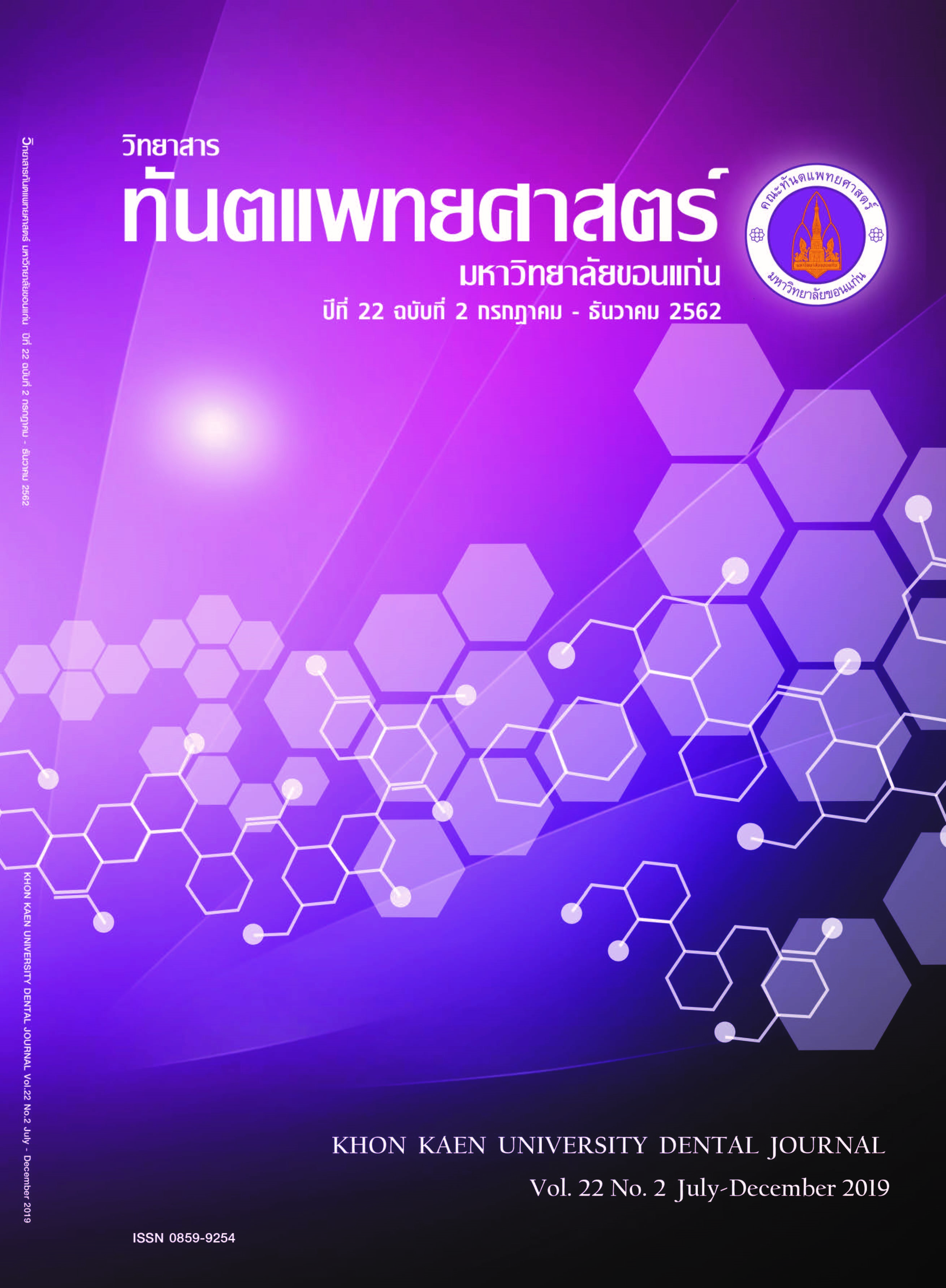ปัจจัยที่มีผลกระทบต่อลักษณะของก้านสไตลอยด์
Main Article Content
บทคัดย่อ
การศึกษานี้มีวัตถุประสงค์เพื่อประเมินรูปร่างของก้านสไตลอยด์ในผู้ป่วยทางทันตกรรมและวิเคราะห์ปัจจัยที่อาจมีผลกระทบ ต่อรูปแบบการสะสมแร่ธาตุของก้านสไตลอยด์ การศึกษานี้ใช้ข้อมูลจากภาพรังสีแพโนรามาระบบดิจิตัลของผู้ป่วยทางทันตกรรม จำนวน 300 ภาพ โดยผู้ป่วยเข้ารับการรักษาทางทันตกรรมอย่างน้อย 1 อย่าง ระหว่างช่วงเดือนตุลาคม ถึงธันวาคม พ.ศ. 2559 ปัจจัยต่างๆ 5 ปัจจัย ได้แก่ เพศ อายุ จำนวนฟันในช่องปาก นิ่วในฟันและด้าน จะถูกบันทึกพร้อมข้อมูลลักษณะก้านสไตลอยด์ซึ่งถูกแบ่งออกเป็น 11 แบบ (เอถึงเค) แบบเอถึงดีจะจัดเป็นกลุ่มที่เป็นก้านสไตลอยด์ปกติ แบบอีเป็นก้านสไตลอยด์ที่ยื่นยาว แบบเอฟถึงเคเป็นเอ็นยึด สไตลอยด์ที่มีแคลเซียมเกาะ ผู้อ่านภาพรังสี 2 คนช่วยกันประเมินภาพรังสีแต่ละภาพ ลักษณะก้านสไตลอยด์แต่ละแบบและปัจจัย ที่เกี่ยวข้องจะถูกวิเคราะห์โดยใช้สถิติเชิงพรรณนา ความสัมพันธ์ระหว่างแต่ละปัจจัยถูกวิคราะห์โดยมัลติเปิ้ลโลจิสติกรีเกรสชัน ผลการศึกษาพบว่าก้านสไตลอยด์แบบดีพบมากที่สุดทั้งสองข้าง คือ 109 (ร้อยละ 36.3) ในด้านขวาและ 125 (ร้อยละ 41.7) ในด้านซ้าย เพศหญิงพบ 207 ราย (ร้อยละ 69) เพศชาย 93 (ร้อยละ31) ในเพศหญิงพบก้านสไตลอยด์ด้านขวาปกติมากกว่าในเพศชาย เป็นเท่า 1.99 อย่างมีนัยสำคัญทางสถิติ ช่วงความเชื่อมั่นร้อยละ 95 = 1.01-3.93 (p=0.048) อายุเฉลี่ย 35.42+ 18.52 ปี ช่วงอายุ 18-88 ปี อายุไม่มีความสัมพันธ์ทางสถิติกับลักษณะก้านสไตลอยด์ จำนวนฟันที่หายไปมีตั้งแต่ 0 ถึง 32 ซี่ ในผู้ป่วย 219 คน (ร้อยละ 73) ไม่มีความแตกต่างอย่างมีนัยสำคัญระหว่าง ผู้ป่วยที่มีฟันและผู้ป่วยไร้ฟัน (p=0.08) นิ่วในฟันพบ 64 ราย (ร้อยละ 21.3) ผู้ที่มีก้านสไตลอยด์ด้านซ้ายปกติจะแสดงลักษณะก้านสไตลอยด์ ด้านขวาปกติด้วยอย่างมีนัยสำคัญทางสถิติ (p<0.0001) กล่าวโดยสรุป ลักษณะและจำนวนของก้านสไตลอยด์ด้านขวาแตกต่างจากด้านซ้าย จำนวนฟันที่เหลือในช่องปากไม่ได้มีผลกระทบต่อลักษณะของก้านสไตลอยด์ เพศและด้านเกี่ยวข้องกับการจัดประเภทลักษณะของก้านสไตลอยด์ และเอ็นยึดสไตโลไฮออยด์
Article Details
บทความ ข้อมูล เนื้อหา รูปภาพ ฯลฯ ทีได้รับการลงตีพิมพ์ในวิทยาสารทันตแพทยศาสตร์ มหาวิทยาลัยขอนแก่นถือเป็นลิขสิทธิ์เฉพาะของคณะทันตแพทยศาสตร์ มหาวิทยาลัยขอนแก่น หากบุคคลหรือหน่วยงานใดต้องการนำทั้งหมดหรือส่วนหนึ่งส่วนใดไปเผยแพร่ต่อหรือเพื่อกระทำการใด ๆ จะต้องได้รับอนุญาตเป็นลายลักษณ์อักษร จากคณะทันตแพทยศาสตร์ มหาวิทยาลัยขอนแก่นก่อนเท่านั้น
เอกสารอ้างอิง
2. Kursoglu P, Unalan F, Erdem T. Radiological evaluation of the styloid process in young adults resident in Turkey’s Yeditepe University Faculty of Dentistry. Oral Surg Oral Med Oral Pathol Oral Radiol Oral Endod 2005;100(4):491-4.
3. Bruno G, De Stefani A, Balasso P, Mazzoleni S, Gracco A J. Elongated styloid process: an epidemiological study on digital panoramic radiographs. Clin Exp Dent 2017;9 (12):e1446-52.
4. Ekici F, Tekbas G, Hamidi C, Onder H, Goya C, Cetincakmak MG, et al. The distribution of stylohyoid chain anatomic variations by age group and gender: an analysis using MDCT. Eur Arch Otorhinolaryngol 2013;270(5):1715-20.
5. Palesy S, Murray GM, De Boever J, Klineberg I. The involvement of the styloid process in head and neck pain- a preliminary study. J Oral Rehabil 2000;27(4):27587.
6. Frommer J. Anatomic variations in the stylohyoid chain and their possible clinical significance. Oral Surg Oral Med Oral Pathol 1974;38(5):659-67.
7. Jelodar S, Ghadirian H, Ketabchi M, Karvigh SA, Alimohamadi M. Bilateral ischemic stroke due to carotid artery compression by abnormally elongated styloid process at both sides: A case report. J Stroke Cerebrovas Dis 2018;27(6):e89-91.
8. Cholitkul V, VipanpongC, Naratippakorn M, Sakchalathorn M, Insook N, Junlasinthanaporn N, et al. Elongated styloid process detected on digital panoramic image. CM Dent J 2015;36(2):57-67.
9. Alpoz E, Akar GC, Celik S, Govsa F, Lomcali G. Prevalence and pattern of stylohyoid chain complex patterns detected by panoramic radiographs among Turkish population. Surg Radiol Anat 2014;36(1):39-46.
10. Omami G. Calcification of the stylohyoid complex in Libyans. Saudi Dental J 2018;30(2):151-4.
11. Shaik MA, N, Kaleem SM, Wahab A, Hameed S. Prevalence of elongated styloid process in Saudi population of Aseer region. Eur J Dent 2013;7(4):449-54.
12. Vieira EM, Guedes OA, De Morais S, De Musis CR, Albuquerque PAA, Borges AH. Prevalence of elongated styloid process in a central Brazilian population. J Clin Diagn Res 2015;9(9):90–2.
13. Sakaew W, Arnanteerakul T, Somintara S, Ratanasuwon S, Uabundit N, Iamsaard S, et al. Sexual dimorphism using the interstyloid distances and clinical implication for elongated styloid process in northeastern Thailand. Int J Morphol 2016;34(4):1223-7.
14. Okabe S, Morimoto Y, Ansai T, Yamada K, Tanaka T, Awano S, et al. Clinical significance and variation of the advanced calcified stylohyoid complex detected by panoramic radiographs among 80-year-old subjects. Dentomaxillofac Radiol 2006;35(3):191-9.
15. Breault MR. Eagle’s syndrome: review of the literature and implications in craniomandibular disorders. J Craniomandibular Pract 1986;4(4):323–37.
16. Malhotra S, Bal RK, Bal CS, Kaur K. Prevalence of pulp stones in North Indian population and its correlation with renal stones - A clinical/radiographic study. Indian J Compr Dent Care 2012;2:127-33.
17. Stenvik A, Mjor IA. Epithelial remnants and denticle formation in the human dental pulp. Acta Odontol Scand 1970;28(5):72–8.
18. Goga R, Chandler N, Oginni AO. Pulp stones: A review. Int Endod J 2008;41(6):457-68.
19. MacDonald-Jankowski DS. Calcification of the stylohyoid complex in Londoners and Hong Kong Chinese. Dentomaxillofac Radiol 2001;30(1):35–9.
20. Radfar L, Amjadi N, Aslani N, Suresh L. Prevalence and clinical significance of elongated calcified styloid processes in panoramic radiographs. Gen Dent 2008;56(6):e29–32.
21. Naheeda, Shaik MA, Kaleem AM, Wahab A, Hameed S. Prevalence of elongated styloid process in Saudi population of Aseer region. Europe J Dent 2013;4(4):449-54.
22. More C, Asrani MK. Evaluation of the styloid process on digital panoramic radiographs. Indian J Radiol Imaging 2010;20(4):261–5.
23. Promthale TV, Chaisuksuni V, Wapinhasmit TR. Anatomical consideration of length and angulation of the styloid process and their significances for eagle’s syndrome in Thais. Siriraj Med J 2012;64(suppl):s30-3.
24. Watanabe PCA, Dias FC, Issa JPM, De Paula FJA, Tiossi R. Elongated styloid process and atheroma in panoramic radiography and its relationship with systemic osteoporosis and osteopenia. Osteoporos Int 2010;21(5):831-6.
25. Anbiaee N, Javadzadeh A. Elongated styloid process: is it a pathological condition?. Indian J Dent Res 2011;229 (5):673-7.
26. Al-Khateeb TH, Al Dajani TM, Jamal GA. Mineralization of the stylohyoid ligament complex in a Jordanian sample: a clinico-radiographic study. J Oral Maxillofac Surg 2010;68(6):1242-51.
27. Basekim CC, Mutlu H, Gungor A, Silit E, Pekkafali Z, Kutlay M, et al. Evaluation of styloid process by three- dimensional computed tomography. Eur Radiol 2005;15 (1):134-9.
28. Gozil R, Yenaer N, Calguner E, Araca M, Tunc E, Bahcelioglu M. Morphological characteristics of styloid process evaluates by computerized axial tomography. Ann Anat 2001;183(6):527-35.
29. Bozkir M G, Boga H, Dere F. The evaluation of elongated styloid process in panoramic radiographs in edentulous patients. Turk J Med Sci 1999:29;481-5.
30. Li S, Blatt N, Jacob J. Provoked Eagle syndrome after dental procedure: A review of the literature. Neuroradiol J 2018; 31(4):426-9.
31. Magat G, Ozcan S. Evaluation of styloid process morphology and calcification types in both genders with different ages and dental status. J Istanb Univ Fac Dent. 2017;51(2): 29–36.
32. Leelarangsun R, Visutiwatanakorn S. Eagle’s syndrome and associated pain in head and neck region: A case report and review literature. M Dent J 2014;34(2):157-65.


